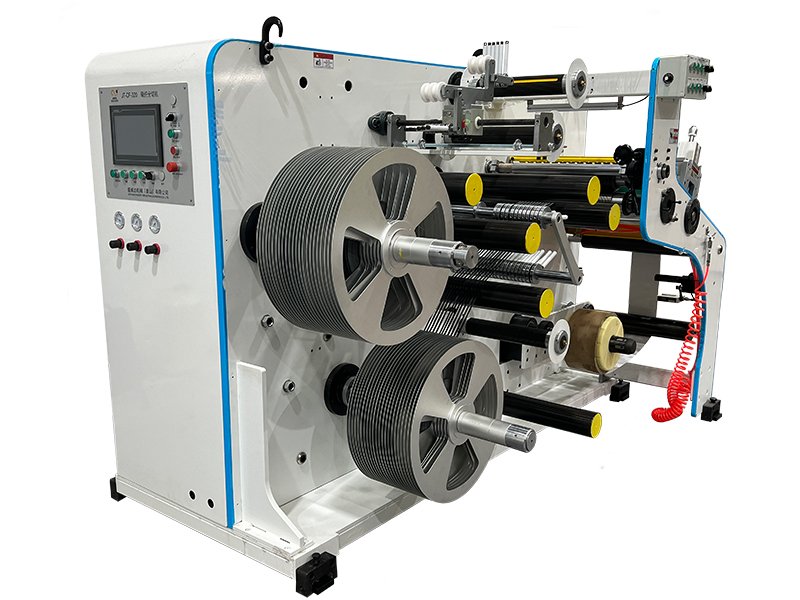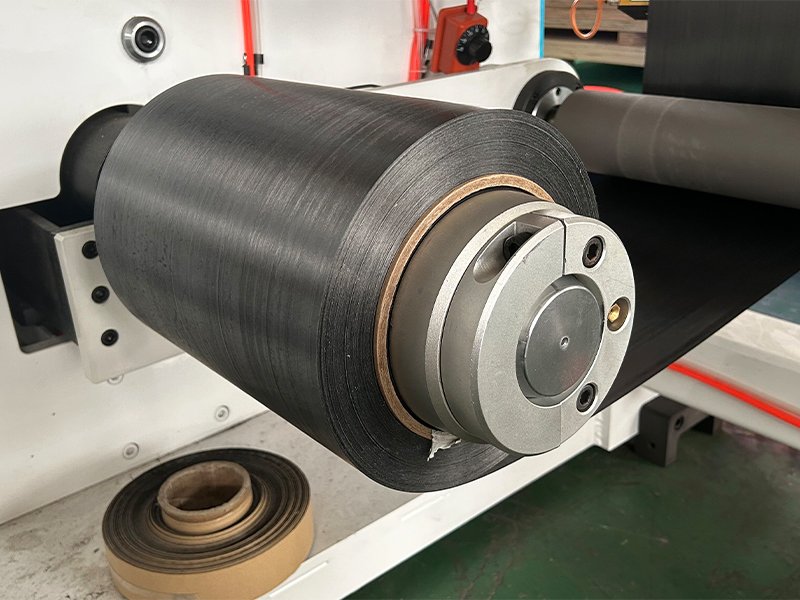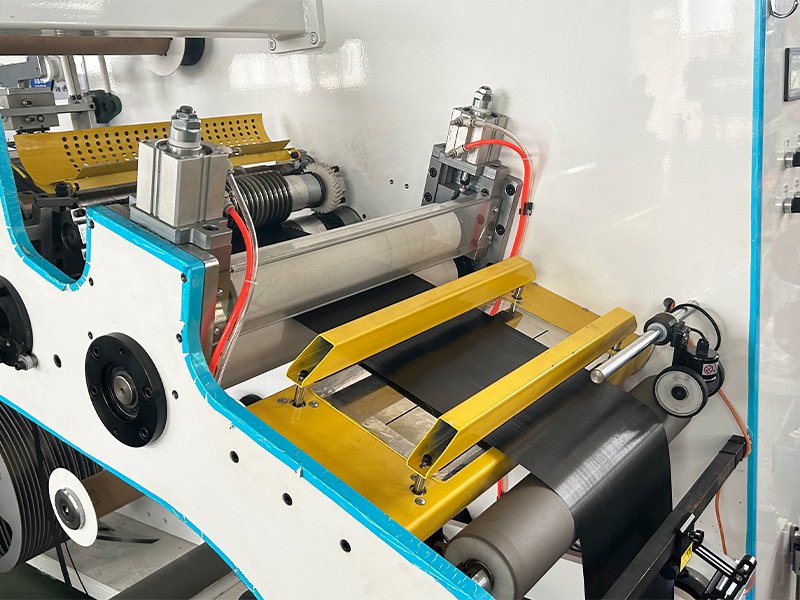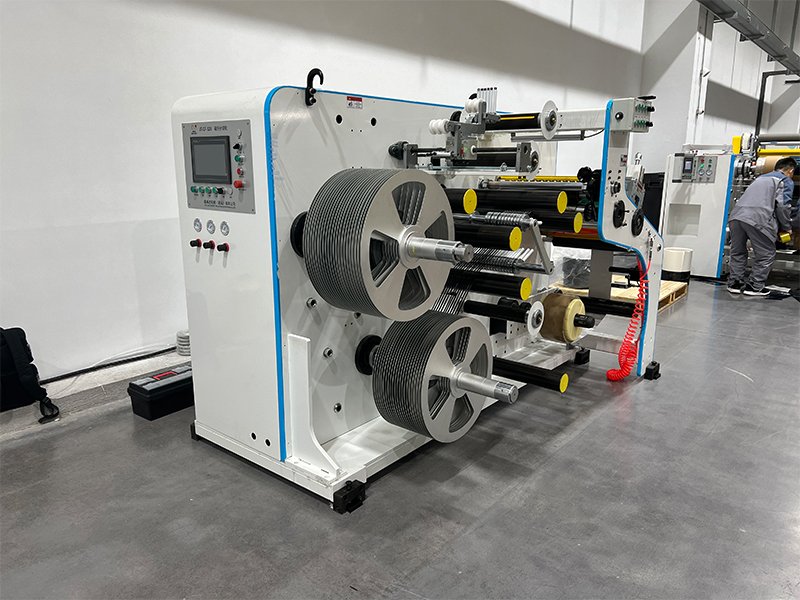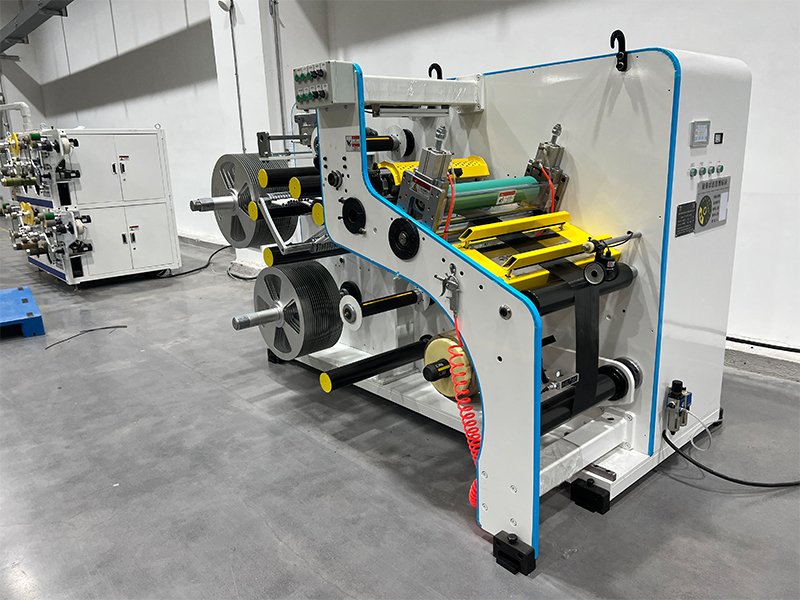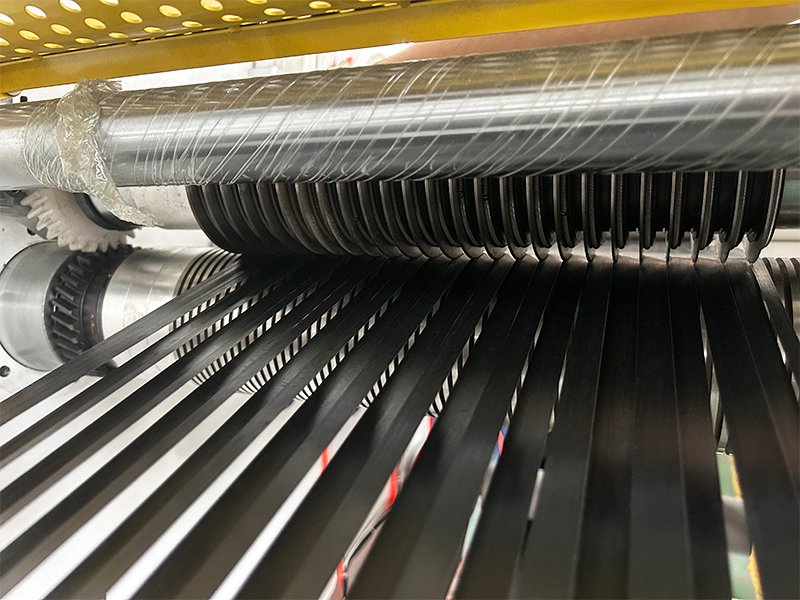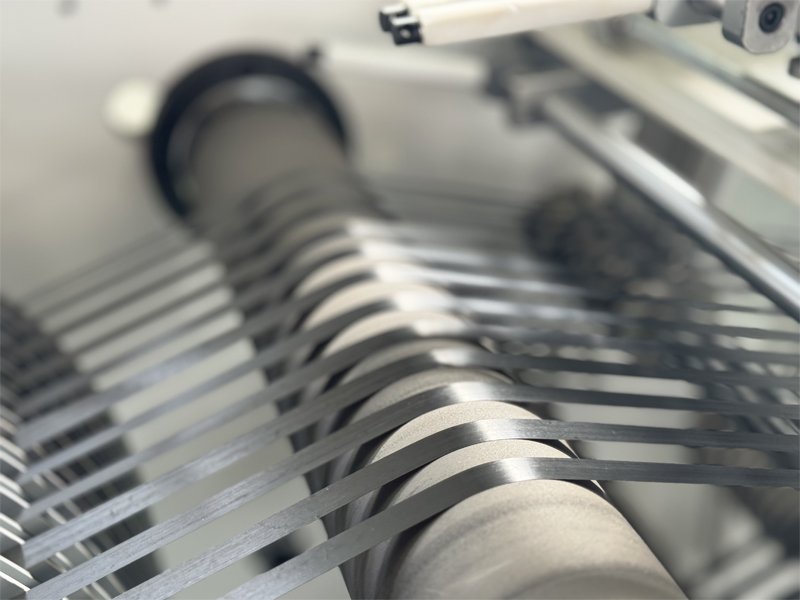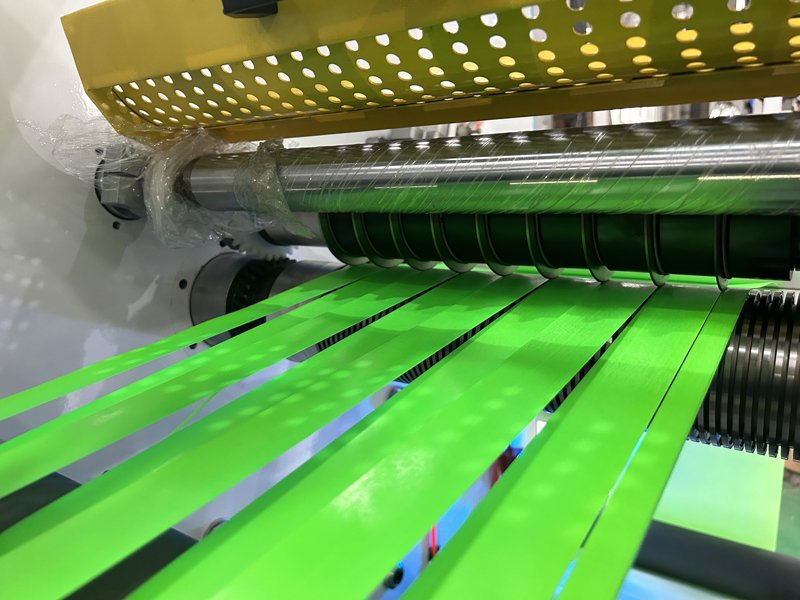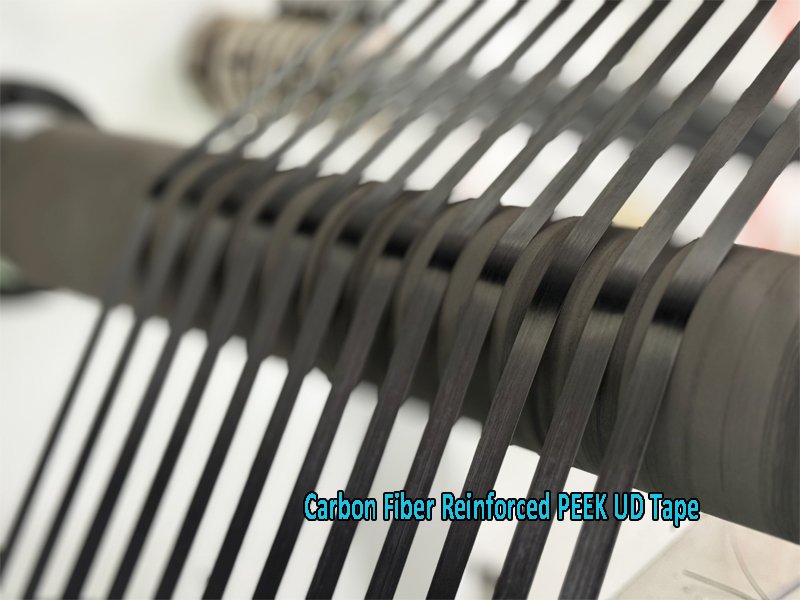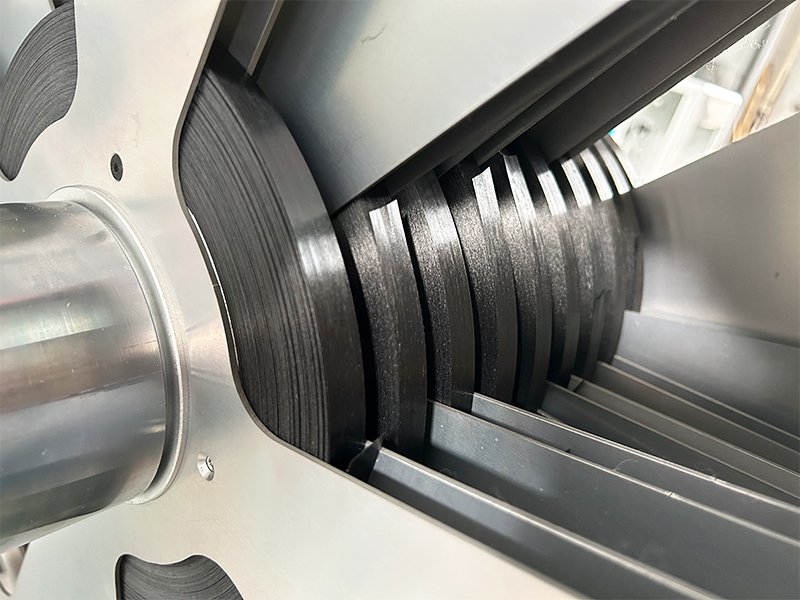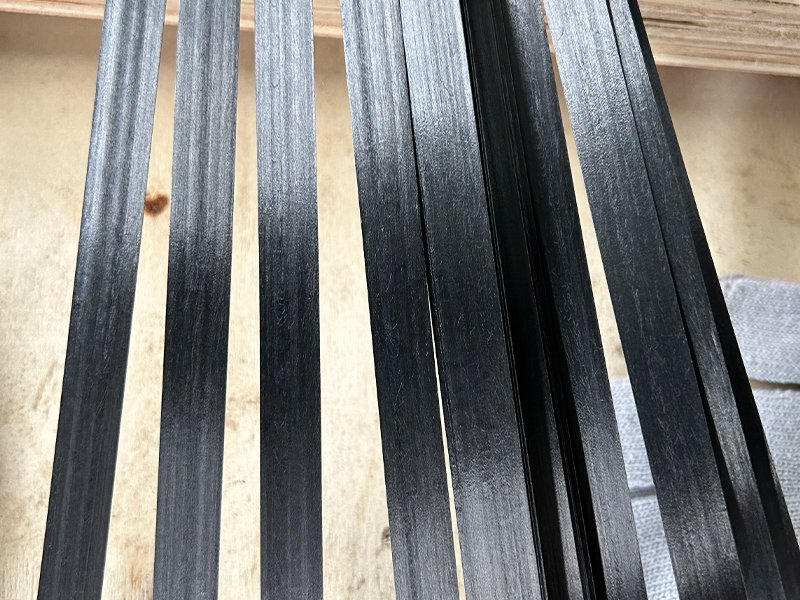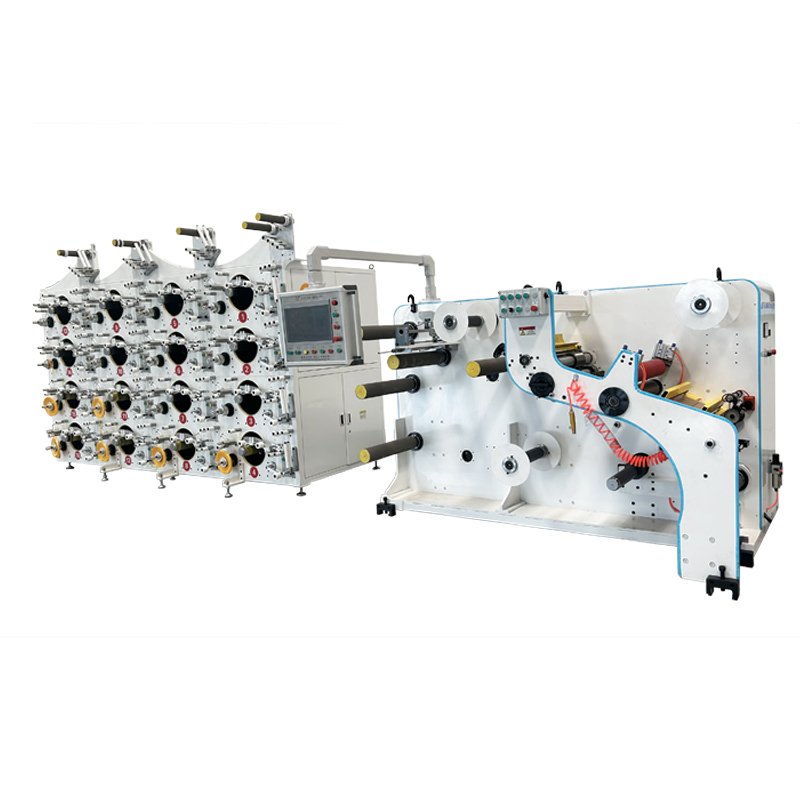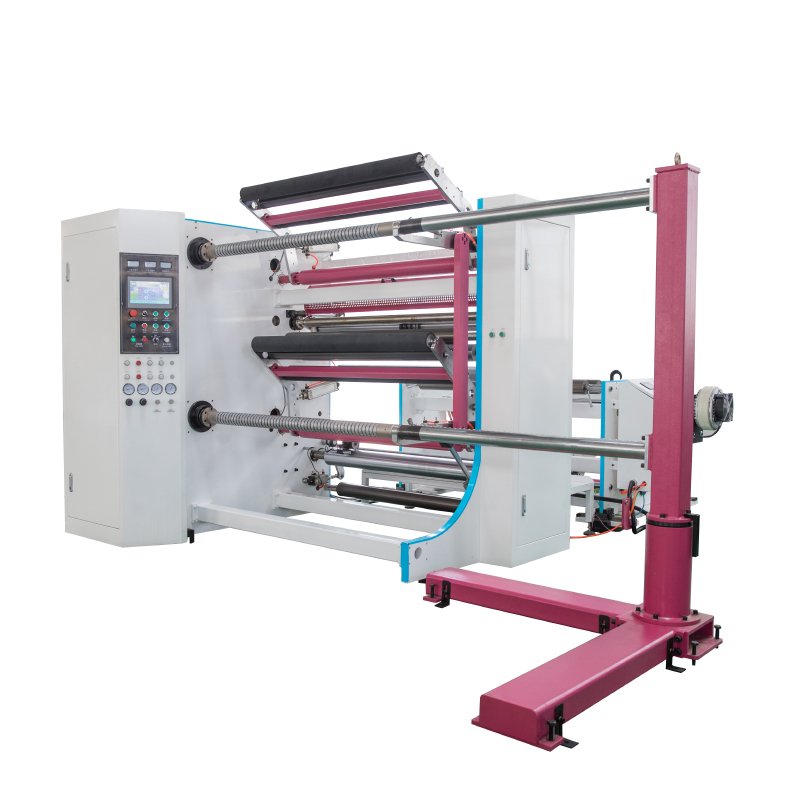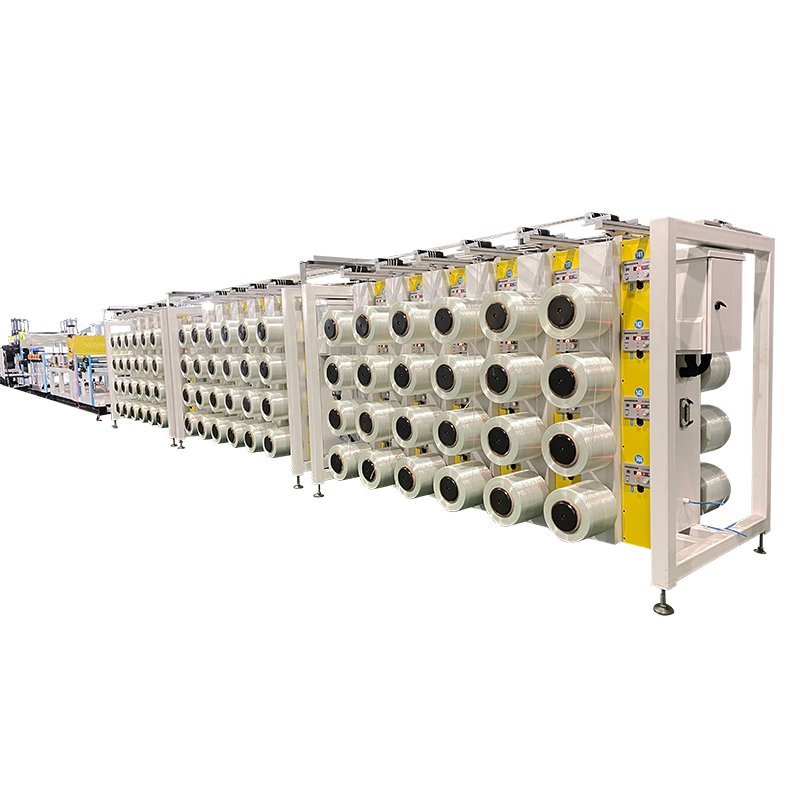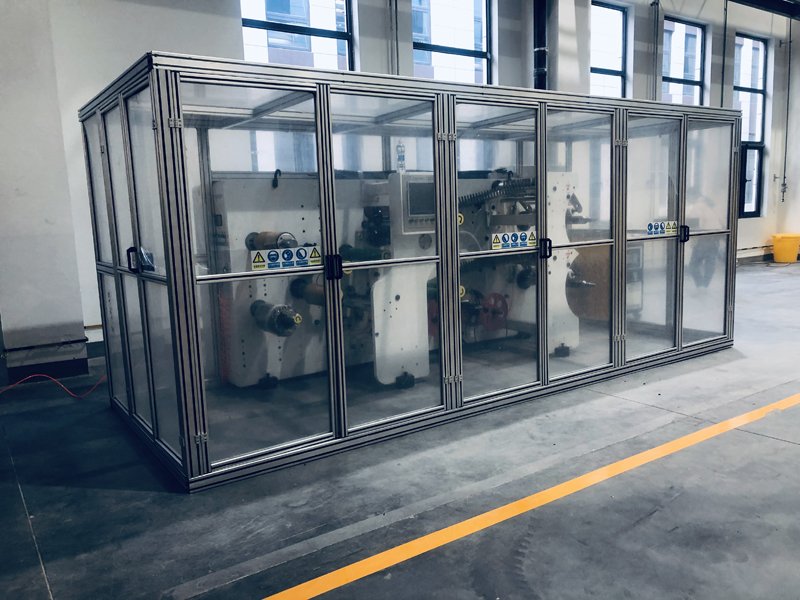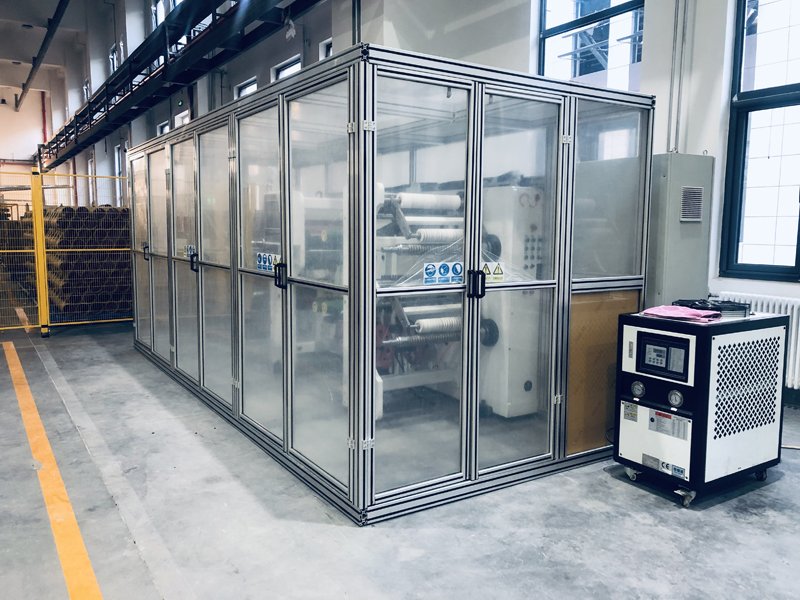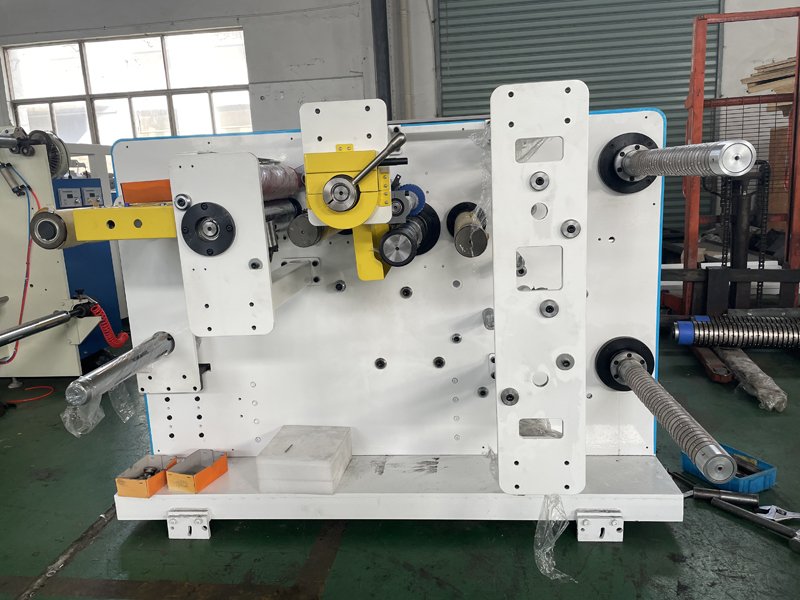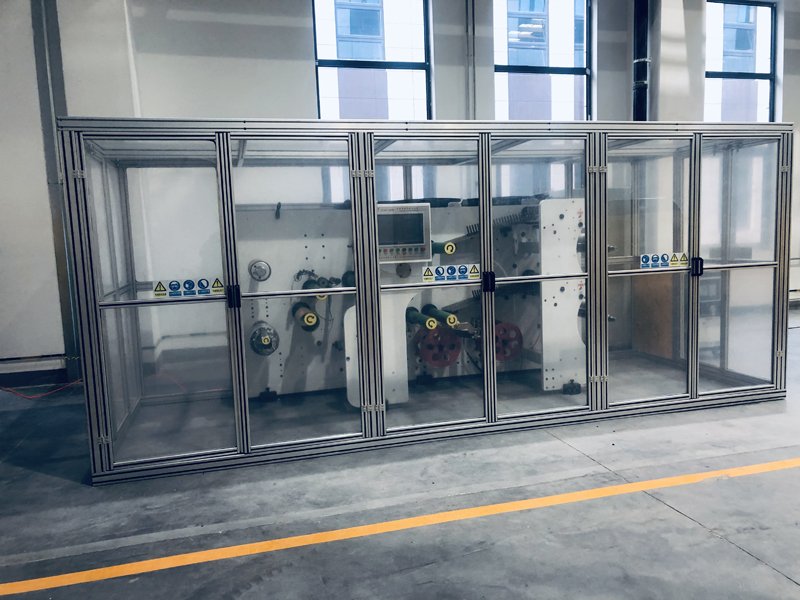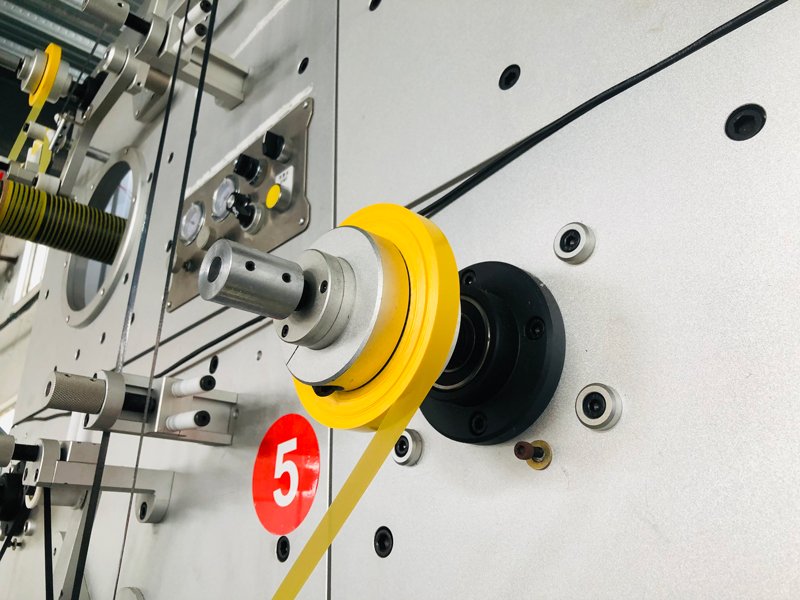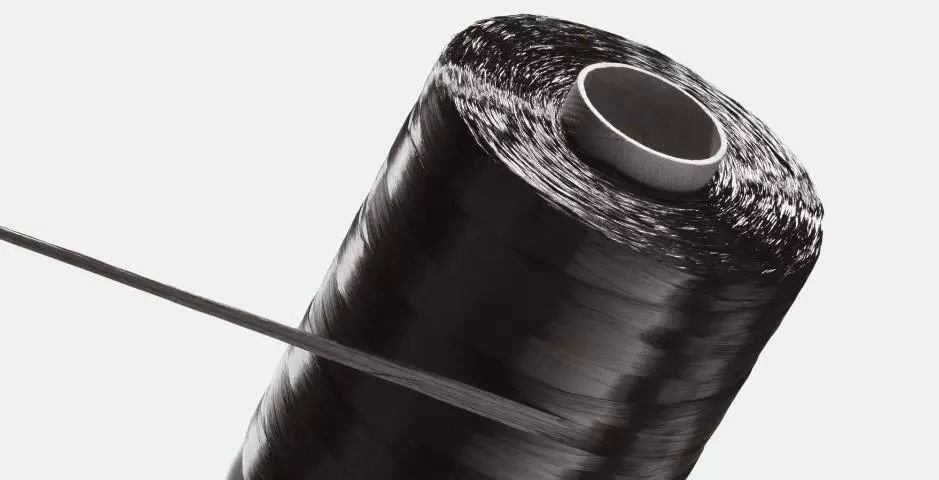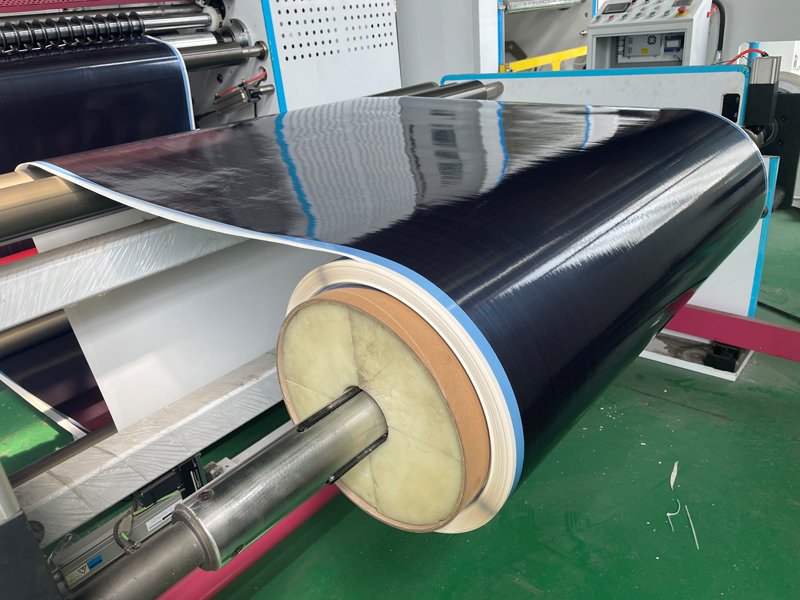CFRTP UD Tape Slitter Rewinder
- Driven by 7 servo motors, whole process is high precision operation
- Easy operation and automatic EPC
- 6.35mm & 12.7mm slitting width can be easily realized
- Online peeling device for thermoplastic composite material
- Two sets of waste edge rewinding wheels
- The transmission station for cutting developed by Jota Machinery
- Specification
- Carbon Fiber Reinforced PEEK UD Tape
| Parameters | |
| Item | JT-SLT-320X Carbon Fiber UD Tape Slitter Rewinder |
| Max. Unwinding Width | 320mm |
| Max Unwinding Diameter | 650mm |
| Max Rewinding Diameter | 500mm |
| Min Slitting Width | 5-320mm |
| Rewinding Shaft | 2 PCS Water Cooling Differential Friction Shaft |
| Unwinding Shaft | 3″ (76mm) air expanding shaft |
| Speed | 50m/min |
| Servo Motor | 7 Sets |
| Tension Control | PLC Control The Tension |
| Rated Power | 11Kw |
| Dimension | 3300MM*1700MM*2000MM |
| Voltage | 380V/50Hz |
| Weight | 3000 KG |
SPECIFICATIONS | |
| JT-SLT-320X Carbon fiber UD tape slitter rewinder is especially design for slitting CFRTP, CFRP, FRP Prepreg, Thermosetting Tapes, Etc. | |
|
Unwinding Section | Two sets unwinding . Upper is for jumbo roll unwinding and lower is the stripped waste collection shaft |
| Both shaft is Φ 3” (76mm), 6″ is optional | |
| 10kg/m2 electromagnetic brake from Taiwan. | |
| Photoelectric sensor web guiding. | |
| EPC Unit | High frequency ultrasonic EPC |
| The EPC motor is a high-speed servo motor, which is efficient and sensitive. | |
| Slitting Section | The machine equips disc blade for slitting and min slit width can reach to 5mm |
| The shaft equipped safety cover | |
|
Tranmission unit | The transfer roller adopts a special wear-resistant and anti-adhesive Teflon roller, and the end of each roller is marked with a sign of the direction of rotation |
| The transmission roller has undergone dynamic and static balance processing, quantity: 5 | |
| Two set waste edge wheels | |
|
Rewinding Unit | 3-inch water cooling differential shaft |
| One for each of the upper and lower | |
| Two set pressure arm for rewinding | |
| Waste Removal | Two sets wheel for rewinding waste edge |
|
Saftey Cover | Aiming at the conductivity of carbon fiber, the machine is equipped with electrostatic isolation protection |
| The whole machine adopts a closed design, covering an area of about 6*3.5 *2.2m | |
| The electrical appliances are fully enclosed design, and the sealing strip realizes the finishing and sealing of the control cabinet | |
| The ventilation fan is equipped with a sponge filter | |
| The whole machine is connected ground wire, and the dangerous parts have safety signs | |
CFRTP Uni-Directional Tape Slitting Rewinding Machine
Last Update Time:31/10/2023
During the 2020 epidemic, two world-class companies approached us and asked if they could cut the thermoplastic UD tape material into 0.25” (6.35mm) width.
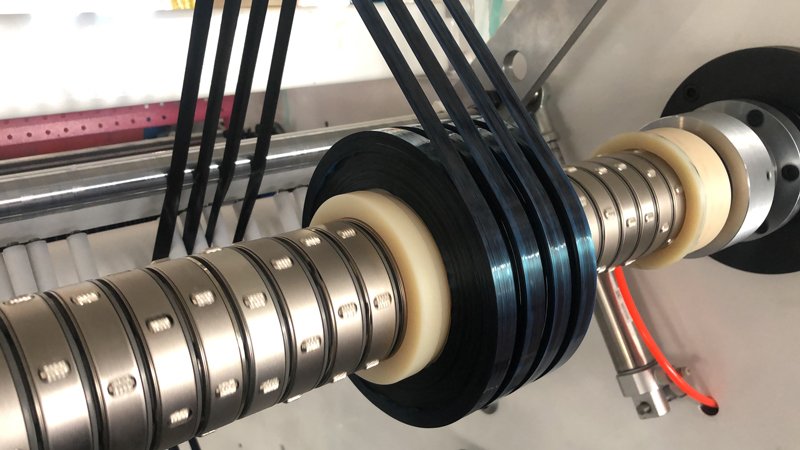
Due to the blockade of the China–United States trade war, thermoplastic materials could not be imported so only one can find a suitable device.
Jota Machinery has more than ten years of experience in the operation of CFRT carbon fiberglass fiber unidirectional tape-related equipment
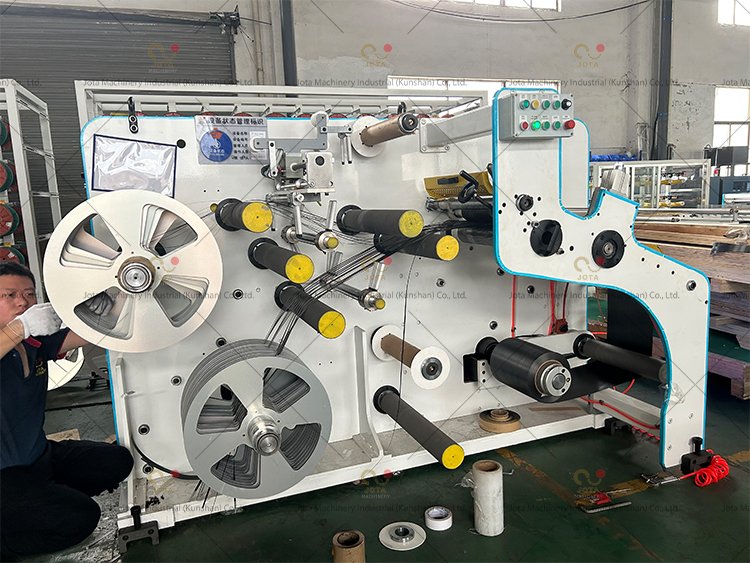
The thermoplastic carbon fiber CFRTP Uni-directional tape slitter rewinder is optimized on the basis of our company’s glass fiber unidirectional tape slitting machine for more than ten years.
We introduced to our customers that this CFRTP Uni-directional tape slitter rewinder is mainly for composite manufacturers who apply automatic tape laying (ATL) technology in the production of prepreg composite material structures.
Since 6.35mm is the common width of the unidirectional tape, we specially customized 6.35mm and 12.7mm cutters of these two-size blades.
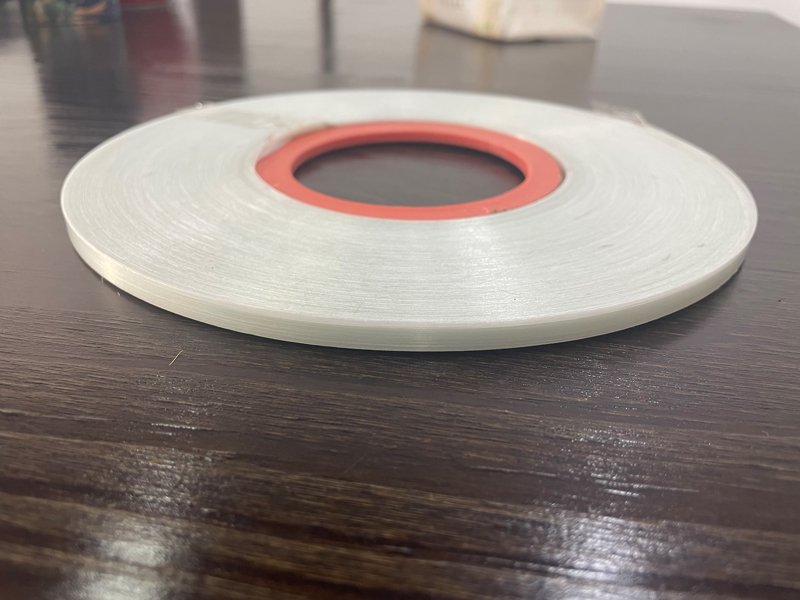
In addition, we also introduced to customers an online peeling device for thermoplastic composite materials.
After many backs and fourth conversations, customers left a deep impression on us and gained trust.
Information about carbon fiber
Carbon fiber is composed of a variety of carbon element materials, and the production process of carbon fiber is complicated.
It is made of composite materials such as organic fibers and graphite crystallites.
Due to the strength and weight of carbon fiber, the performance will be better than other materials.
The production of carbon fiber
Carbon fibers can be prepared by solid-phase carbonization of high molecular weight organic fibers or gas-phase pyrolysis of low molecular weight hydrocarbons.
Most of the carbon fibers sold in the previous world are made by solid-phase carbonization of polyacrylonitrile fibers.
The resulting step is pre-oxidation: heating in air and maintaining at 200-300 degrees for tens to hundreds of minutes.
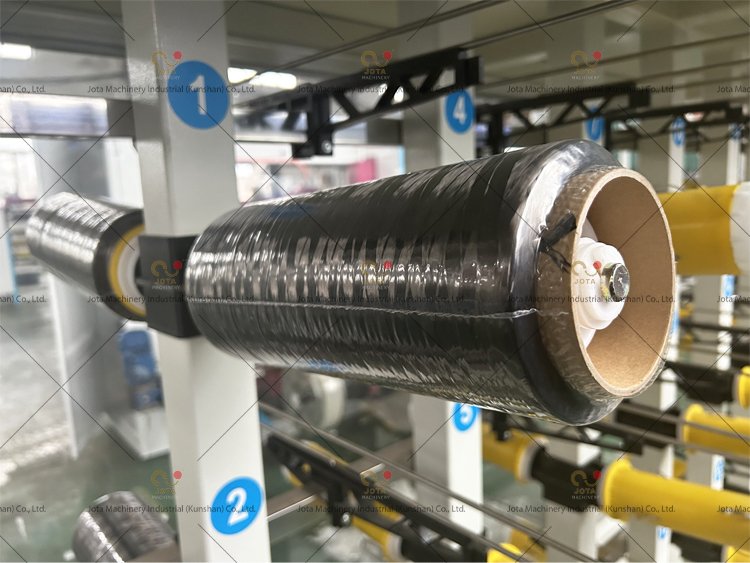
The purpose of pre-oxidation is to convert the linear molecular chain of polyacrylonitrile into a heat-resistant ladder structure so that it does not melt and burn during high-temperature carbonization and maintains the fiber state.
B Carbonization: Heat to 1200-1600 degrees in an inert atmosphere and maintain it for several minutes to tens of minutes to produce carbon fiber; the inert gas used can be high-purity nitrogen, argon, or helium, but generally high-purity Nitrogen.
C Graphitization: then heat to 2000-3000 degrees in an inert atmosphere (generally high-purity argon) and maintain it for several seconds to tens of seconds; the carbon fiber produced in this way is also called graphite fiber.
CFRTP Uni-directional tape slitter rewinder
Jota Machinery is committed to the research and development, production, and service of various slitting equipment for more than 20 years, and CFRT carbon fiber/vinyl glass fiber unidirectional tape-related equipment has more than ten years of experience.
The CFRTP Uni-directional tape slitting machine is optimized on the basis of our company’s glass fiber unidirectional tape slitting machine for more than ten years.
We combine advanced material technology with world-class technical services, global manufacturing capabilities, and unique customer-centric business models to help our customers succeed.
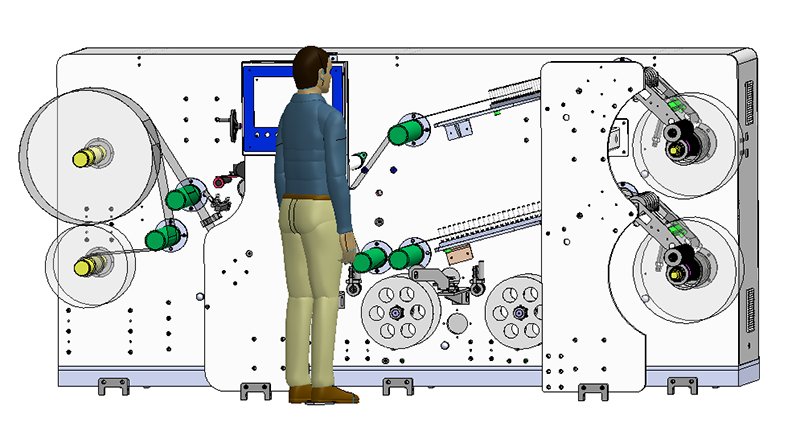
JT-SLT-320X is suitable for new composite material carbon fiber, glass fiber reinforced thermoplastic, and thermosetting plastic unidirectional prepreg tapes, such as CFRTP, CFRP, FRP PREPREG, THERMOSETTING UD TAPES, and other materials slitting and rewinding.
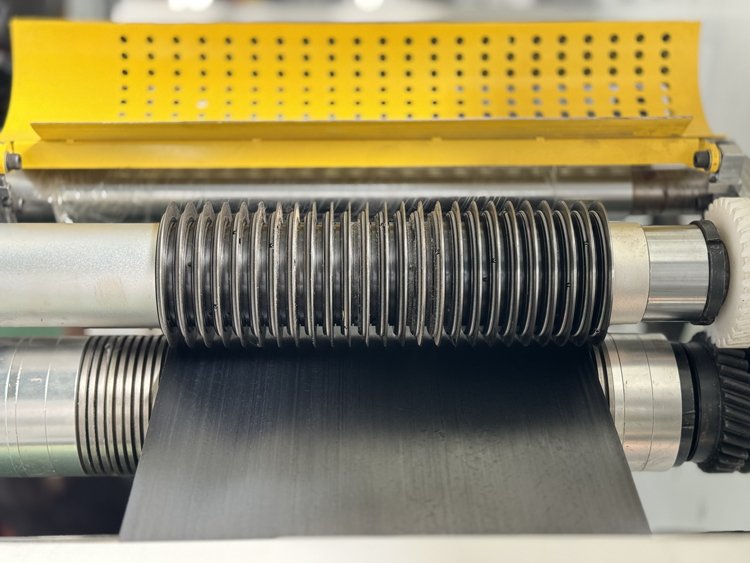
This equipment uses a 3-inch air-expanding shaft as the unwinding device. The maximum unwinding width can reach 320mm.
There are totally 2 air-expanding shafts in the upper and lower positions.
The upper shaft is used for the unwinding of the jumbo roll, and the lower shaft is the unwinding shaft for stripping waste. . The two devices are integrated and the operation is more convenient.
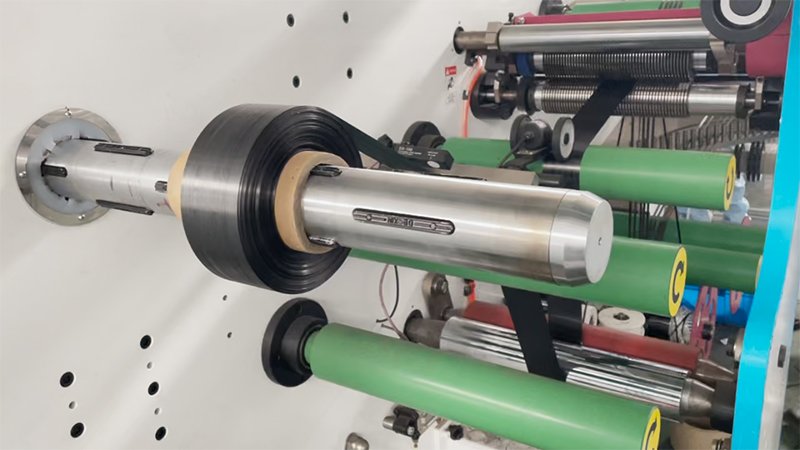
Application of carbon fiber:
The main purpose of carbon fiber is to composite with resin, metal, ceramics, and carbon as reinforcing material to make advanced composite materials.
Carbon fiber-reinforced epoxy resin composites have the highest specific strength and specific modulus among existing engineering materials.
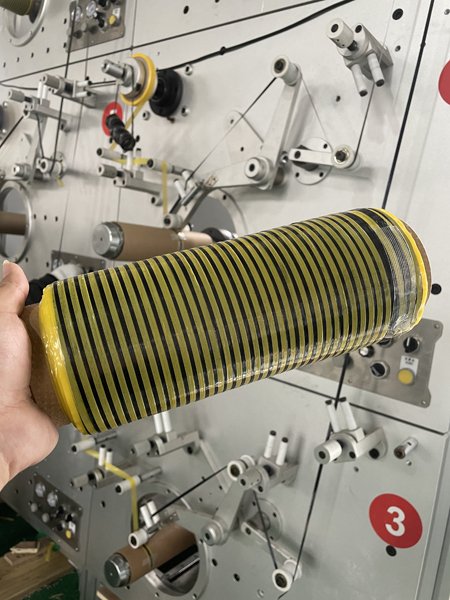
Carbon fiber can be processed into fabric, felt, mat, belt, paper, and other materials.
Carbon fiber is generally not used alone except as a thermal insulation material.
It is often added as a reinforcing material to resin, metal, ceramics, concrete, and other materials to form composite materials.
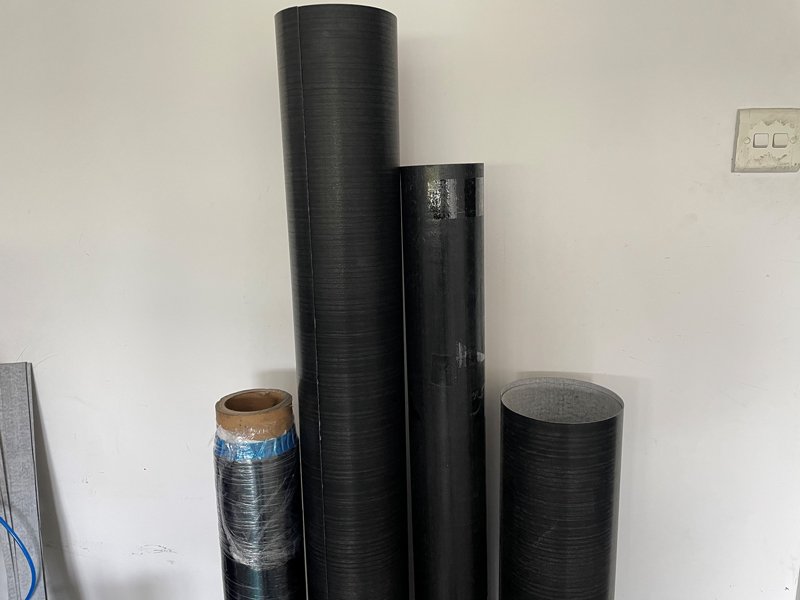
Carbon fiber-reinforced composite materials can be used as body substitute materials such as aircraft structure materials, electromagnetic shielding materials, artificial ligaments, etc., and for the manufacture of rocket shells, motorboats, industrial robots, automobile leaf springs, and drive shafts.
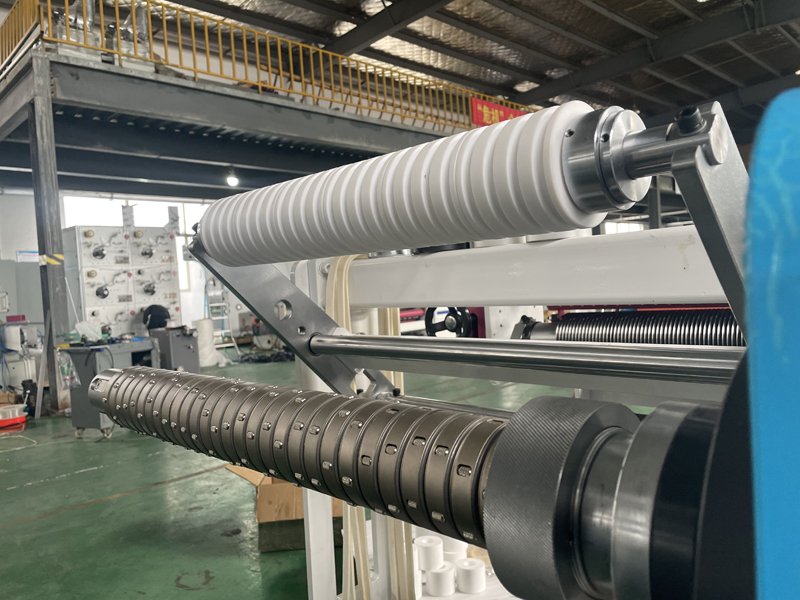
At present, there are many practical applications, and there should be two kinds of carbon fiber resin matrix composite materials and carbon/carbon composite materials belonging to carbon fiber materials.
Among them, carbon fiber reinforced resin-based composite materials (CFRP) have a series of outstanding properties such as being lightweight.
In areas that have strict requirements on weight, stiffness, and fatigue characteristics, and where high temperature and high chemical stability are required, carbon fiber composite materials have great advantages.
Carbon fiber properties:
Due to the high carbon content, man-made chemical fibers that do not melt during the heat treatment process are made by processes such as thermally stable oxidation treatment, carbonization treatment, and graphitization.
Carbon fiber products have been widely used in many fields by virtue of the following 10 properties:
Lightweight, high strength, high modulus
Carbon fiber has a density between 1.6 and 2.5 g/cm3 and a tensile strength of more than 2.2 GPA.
It has a specific modulus that is more than five times that of metals and a specific modulus that is greater than seven times that of the majority of metals.
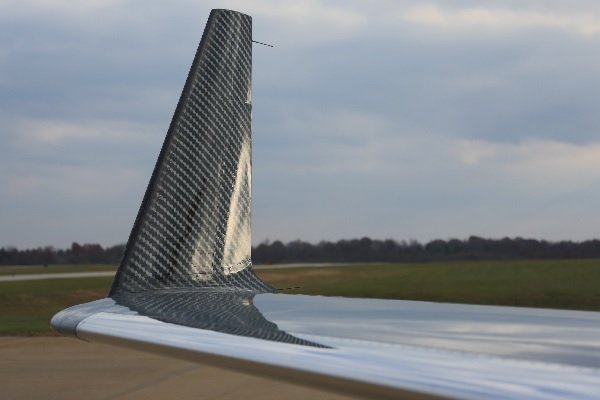
Due to this benefit, its composite materials can be utilized extensively in the aerospace, automobile, and sports equipment industries, etc.
Small thermal expansion coefficient
The thermal expansion coefficient of most carbon fiber itself is negative indoors (-0.5~-1.6)×10-6/K, zero at 200~400℃, and 1.5×10-6/K when it is less than 1000℃.
The composite material made of it has a relatively stable expansion coefficient and can be used as a standard weighing instrument.
Good thermal conductivity
Generally, the thermal conductivity of inorganic and organic materials is poor, but the thermal conductivity of carbon fiber is close to that of steel.
Taking advantage of this advantage, it can be used as a material for solar heat collectors and a heat-conducting shell material with uniform heat transfer.
Good chemical resistance
Carbon is one of the most stable elements, which can be deduced from the composition of carbon fiber, which is nearly pure carbon.
It is resistant to strong oxidizing acids, as well as acids, alkalis, and organic chemicals, and can be processed into a variety of chemical antiseptics.
My nation has been conducting applied research in this area, and as the price of carbon fiber continues to fall in the future, its range of applications will expand.
Good wear resistance
Carbon fiber and metal are rarely worn when rubbing against each other.
Carbon fiber is used to replace asbestos to make high-grade friction materials, which have been used as brake pad materials for airplanes and automobiles.
Good high-temperature resistance
The performance of carbon fiber is very stable below 400°C, and there is not much change even at 1000°C.
The high-temperature resistance of composite materials mainly depends on the heat resistance of the matrix.
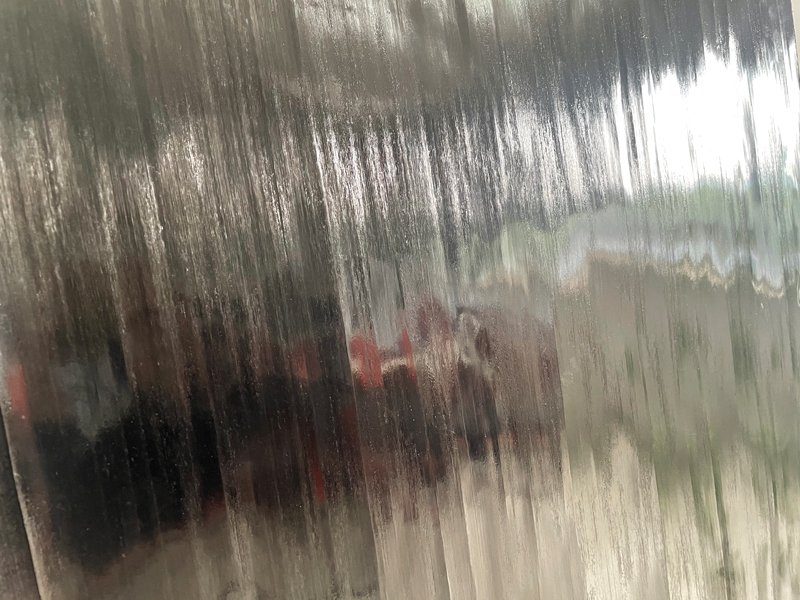
The long-term heat resistance of resin-based composite materials is only about 300℃, and the high-temperature resistance of ceramic-based, carbon-based, and metal-based composite materials can match the carbon fiber itself.
Therefore, carbon fiber composite materials are widely used in the aerospace industry as high-temperature resistant materials.
Outstanding damping and excellent transparent sonar
These two characteristics can be used as structural materials for submarines, such as the sonar dome of submarines.
High X-ray transmittance
This feature has been applied in medical equipment.
High fatigue strength
The structure of carbon fiber is stable, and the composite material made of stress fatigue has a strong retention rate of 60% after millions of cycles of stress fatigue testing, compared with 40% for steel, 30% for aluminum, and only 20% for glass fiber reinforced plastic. -25%.
Therefore, the safety factor of design products is the lowest with carbon fiber composite materials.
The whole machine is equipped with 5 statically balanced anti-stick Teflon sticks, and the end of each stick is equipped with a direction of rotation.
CFRTP Uni-directional tape slitter rewinder uses a round knife to slit the carbon fiber, the smallest slitting width can reach 5mm and is equipped with 2 waste edge devices.
The slitting knife structure is a patented product of our company.
It is aimed at the carbon fiber unidirectional belt and has professional standards in the material of the blade, the angle of the blade, and the depth of bite.
When slitting materials, neat edges, no burrs, and no damage to the fiber.
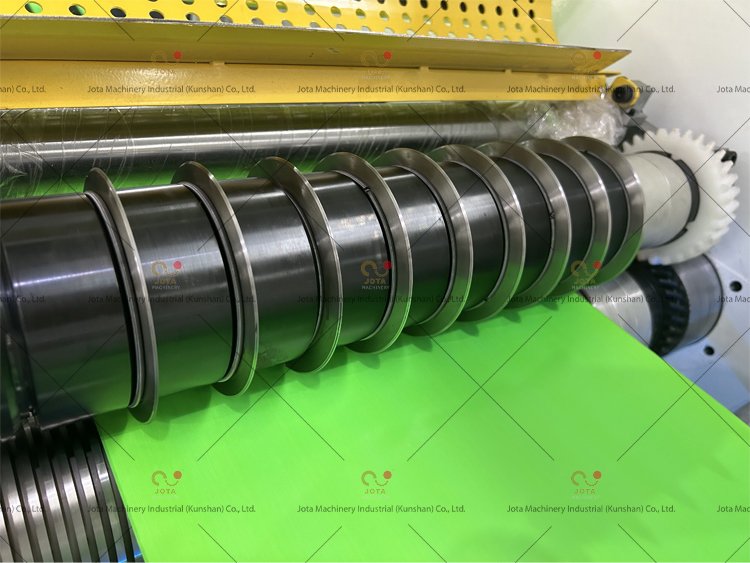
Rewinding device
A set of pressure arm devices for the upper and lower shafts adopts a 3-inch water-cooled differential shaft.
The pressure arm provides good tension and pressure to ensure that the winding structure is tight and not loose.
Even without a reel, it can be rewound normally. The cooperation of the pressure arm and the differential shaft can achieve a better rewinding effect.
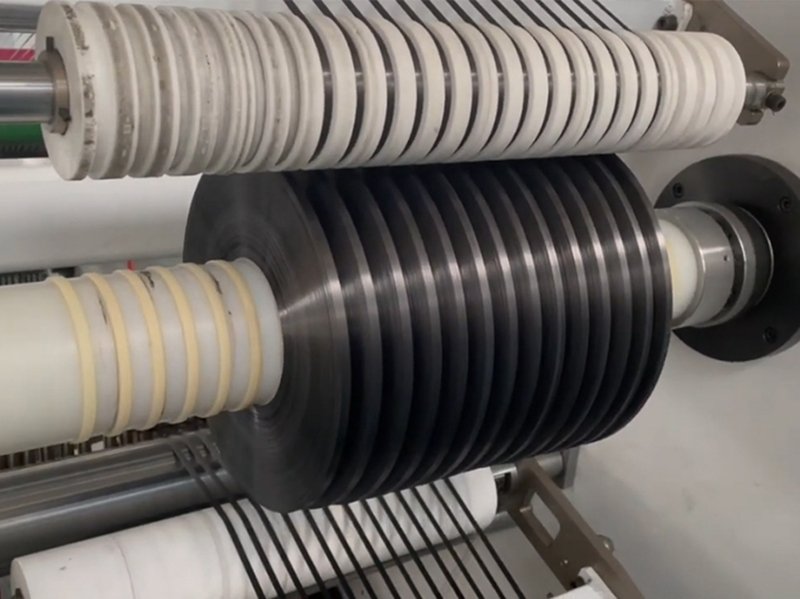
The safety protection device of JT-SLT-320X carbon fiber CFRTP Uni-directional tape slitter rewinder
Due to the good hydroelectricity of carbon fiber, carbon fiber dust as conductive dust causes great persecution to electrical equipment.
Carbon fiber dust can enter electrical equipment with a lower level of dust resistance, short-circuit electrical components, and damage electrical equipment.
At the same time, it has a destructive effect on the insulation of electrical equipment. And further, reduce its insulation resistance.
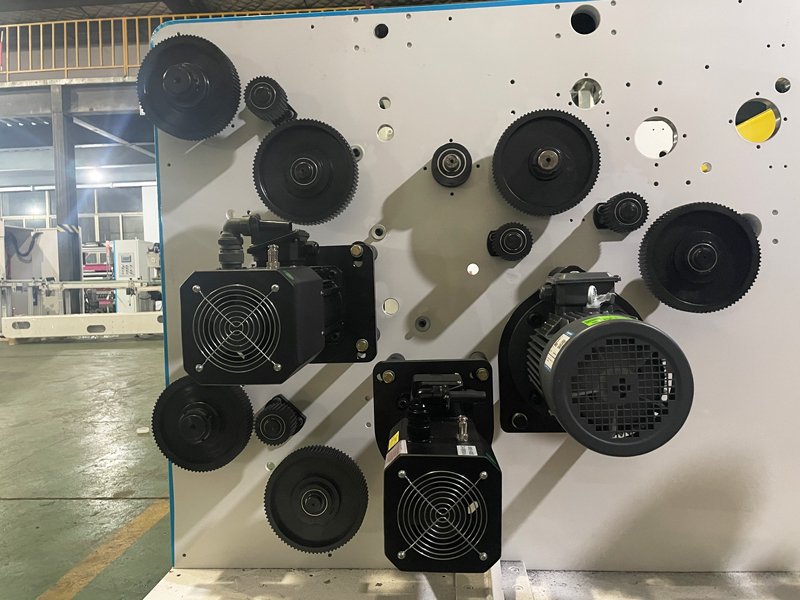
Put dangerous voltages on metal parts such as electrical equipment enclosures, bases, and hoods.
And this caused an electric shock incident.
In order to address this performance, the machine is equipped with electrostatic isolation protection devices, and the whole machine adopts a closed design, covering an area of about 21 square meters.
We also adopted a closed design for the electrical appliances and added a sealing strip to achieve the overall sealing of the control cabinet, and the ventilation fan is also equipped with a sponge filter.
Application of carbon fiber
Application of carbon fiber composite materials in aerospace
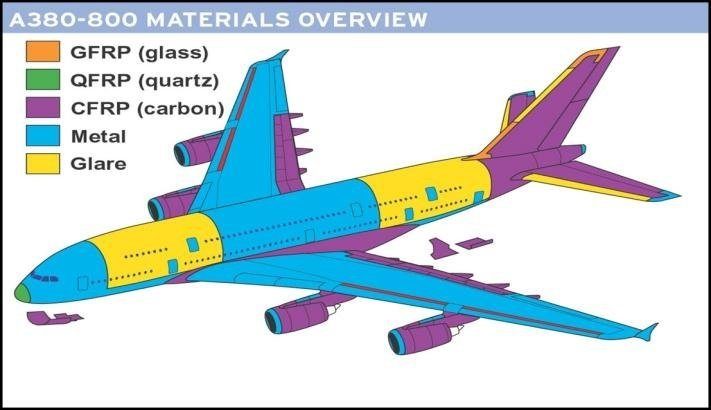
In fighter jets and helicopters, carbon fiber composite materials are used in the main structure, sub-structures, and special functional parts of the fighter aircraft.
The application of carbon fiber/epoxy and carbon fiber/dual horse composite materials in the fuselage, main wing, vertical tail, flat tail, and skin of fighter aircraft has played a significant role in weight reduction and greatly improved fatigue resistance and corrosion resistance.
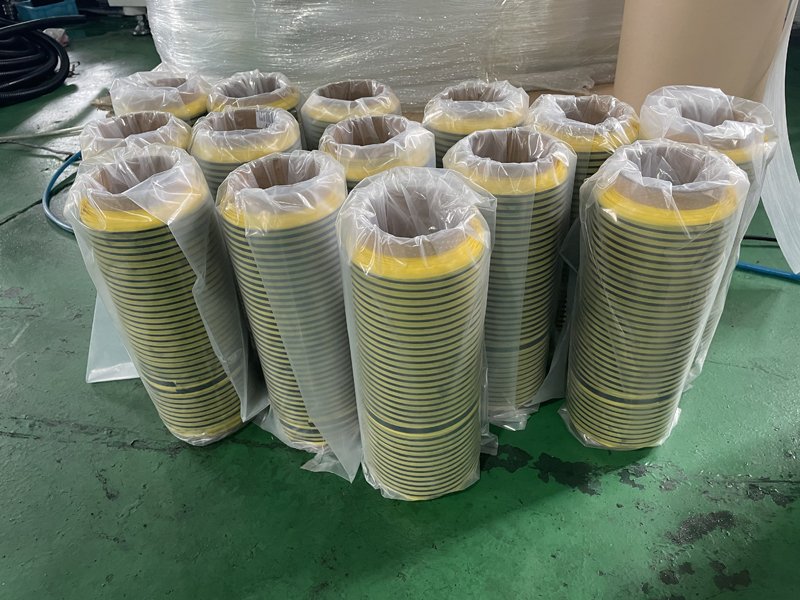
The data shows that the composite material structure of the front fuselage section can reduce the mass by 31.5%, 61.5% of the parts, and 61.3% of the fasteners compared with the metal structure; the composite vertical stabilizer can reduce the mass by 32.24%.
Application of carbon fiber racing car industry
As a high-strength, lightweight emerging material, carbon fiber has been widely used in racing and aviation.
Recently, Goodyear, a global tire technology leader, announced that it has applied carbon fiber technology to civilian tire products.
It is reported that Porsche has introduced a pure carbon fiber reinforced plastic wheel, which will be configured in the 911 Turbo S Exclusive Series in early 2018.
In this way, Porsche will also become the world’s first car company to launch wheels of this material.
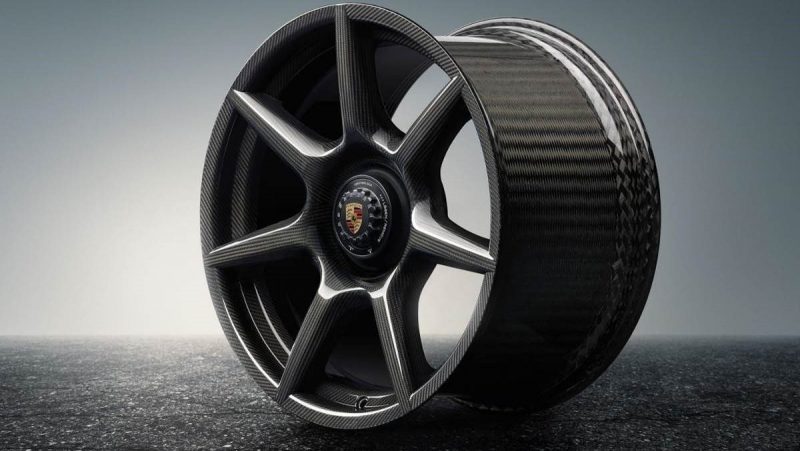
The composite wheel weighs 19 pounds, which is 20% lighter than the equivalent aluminum alloy wheel, but Porsche also said that the wheel is also 20% tougher than the equivalent wheel, and a complete set of wheels is priced at more than $17,600.
Carbon fiber application development
In 2019, the global carbon fiber belt market size is estimated at 1.8 billion U.S. dollars, and the compound annual growth rate (CAGR) is expected to be 13.4% from 2020 to 2026.
The emergence of carbon fiber is one of the key materials to achieving lightweight.
The construction of automotive and aerospace components is expected to drive the market in the future.
Extension products about carbon fiber
Carbon fiber weaves
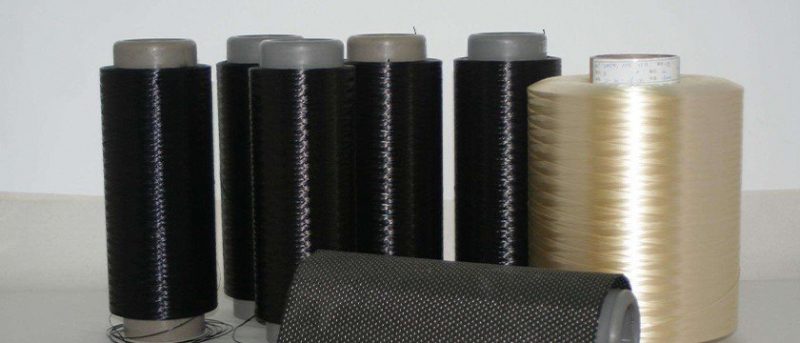
According to the number of monofilaments in the carbon fiber tow, carbon fiber can be divided into small tow and large tow.
Compared with small tows, the disadvantage of large tows is that the tows are not suitable for unfolding when making plates and other structures, which leads to an increase in the thickness of a single layer, which is not conducive to structural design.
In addition, there are more phenomena such as adhesion and wire breakage of large two-carbon fibers, which will affect the strength and stiffness, reduce the performance, and the dispersion of the performance will be greater.
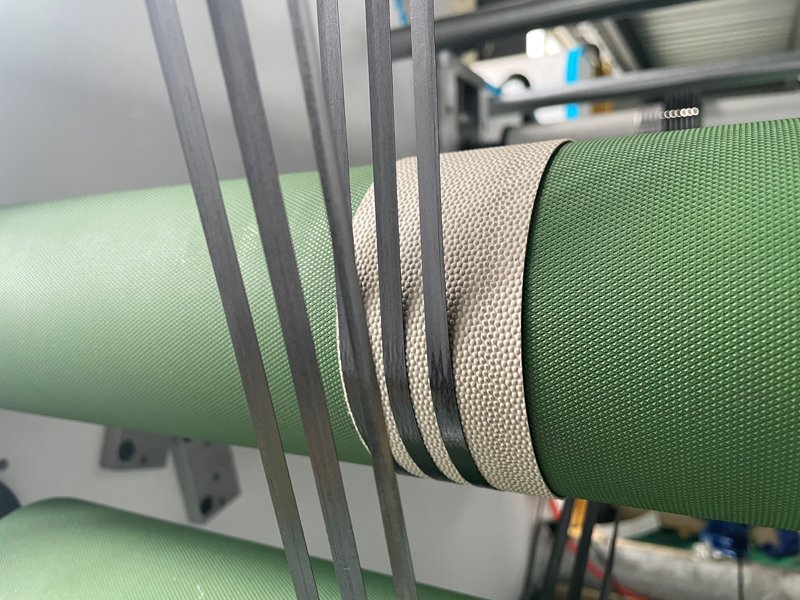
Aircraft and spacecraft generally only use small tow carbon fibers, so small tow carbon fibers are also called “space-grade” carbon fibers, and large tow carbon fibers are called “industrial-grade” carbon fibers.
The number of single fibers contained in each bundle of carbon fibers is an important indicator of carbon fibers. Large-tow carbon fiber usually refers to fiber bundles with 48,000 carbon fibers (48k) or more, including 50,000 (50k), 60,000 (60k), 120,000 (120k), 360,000 (360k), etc.
while small-town carbon fiber refers to fiber Carbon fiber bundles with a number of less than 48k, such as 1000 (1k), 3000 (3k), 12000 (12k), 24000 (24k), etc.
Because large tow carbon fiber (≥48K, that is, a bundle of filaments contains 48,000 carbon filaments) has the advantages of low price, easy source, and performance equivalent to 12K carbon fiber, its composite materials are used in fishing rods, golf clubs, building reinforcement, Natural gas storage tanks, medical equipment, etc. are widely used.
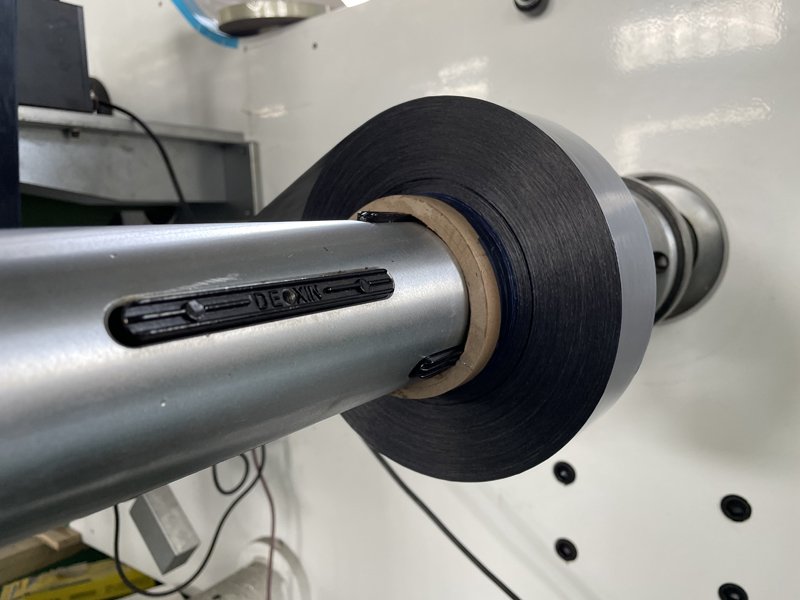
As the price of large tow carbon fiber further decreases, its application fields will continue to expand.
At present, 3K-12K carbon fiber is mainly used in composite materials in the aerospace field, and there has not been a report of the application of large tow carbon fiber in this field.
The key to its application in the aerospace field depends on the mechanical properties and stability of its composite materials.
Small tow carbon fiber enterprise
Japan’s Toray, Teijin, and Mitsubishi companies are relatively similar, with a comprehensive product range, ranging from standard modulus, medium modulus to high modulus, complete mechanical properties, rich varieties and specifications, and their production capacity is mainly concentrated in small tows.
In aerospace and high-end sports equipment, it is known as the “troika” leading the world’s carbon fiber development.
Especially after the world entered the era of energy-saving and emission reduction, these famous carbon fiber companies in Japan first cooperated with the two major aircraft manufacturing companies, Boeing and Airbus.
A large number of carbon fiber composite materials have been used in the B787 Dreamliner and A380 Sky Giant aircraft successively, breaking through the revolutionary innovation of more than 50% of the advanced composite material structure on the large civil aviation aircraft.
On this basis, they took the initiative to join forces with European, American, and Japanese auto companies to seize the opportunity and vigorously develop new energy composite vehicles.
Formosa Plastics entered the carbon fiber field after acquiring the American Hitco carbonization technology in 1984.
It mainly produces 12k carbon fiber, ranking fourth in the world in terms of production capacity.
Its carbon fiber is mainly used in the sports equipment field of Taiwan-funded enterprises; both Hexcel and Cytec in the United States produce small silk Hexcel has high-strength and mid-mode carbon fibers.
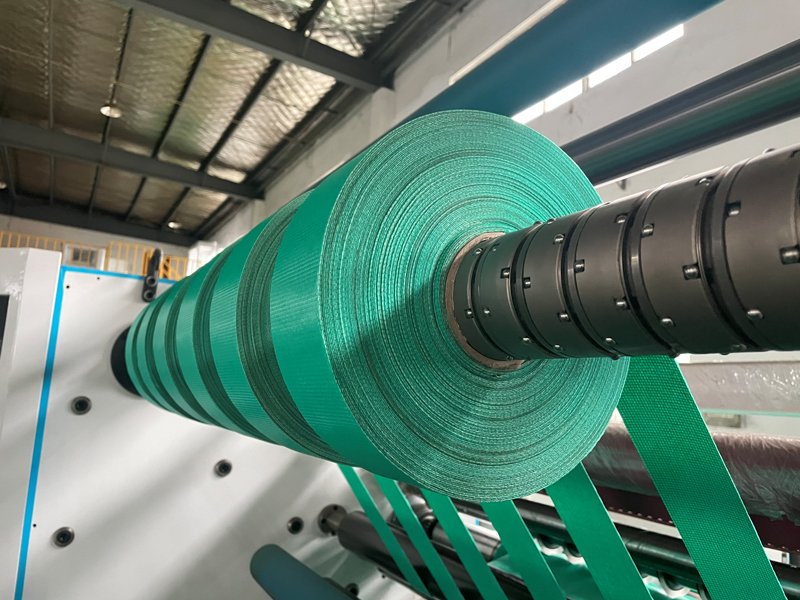
Cytec only has ordinary PAN carbon fibers and the best pitch-based carbon fibers in the world. Before Toray entered Boeing, their prepregs basically monopolized the US aerospace industry.
Composite materials (especially military products) market, while also supplying carbon fiber composite parts.
Large tow carbon fiber enterprise
The United States Zoltek entered carbon fiber through the acquisition of Stackpole Fibers in 1988.
In 1992, Zoltek established the first continuous carbonization line based on industrial acrylic fiber, locking its strategic goal in low-cost industrial applications
in 1995, Zoltek acquired acrylic fiber in Hungary.
In 1999, Zoltek acquired 4 composite materials companies, including material design, prepreg, and composite material equipment companies, and strived to advance to the downstream of carbon fiber; after entering the new century, Zoltek sold a large amount of carbon fiber and its products in the field of wind power blades.
Carbon fiber prepreg, at the same time, actively explores the automotive market. Germany SGL entered the carbon fiber field through the acquisition of British RK Carbon in 1997
In 1998, it established a carbon fiber carbonization plant with the American golf club company Aldila, with an 1100 t/a production capacity.
In 2010, the joint venture with BMW invested in carbon fiber carbonization in the United States Line, dedicated to BMW automotive composite materials.
Mitsubishi of Japan has shifted its product development strategy from small tow cross-border to large tow, confident about the rising international wind power sector market and future low-cost, high-performance.
Mitsubishi provides the needed precursor for SGL and BMW’s large-tow carbon fiber carbonization facility in the U.S.
How to divide carbon fiber large tow and small tow?
First of all, we must know that the thickness of each carbon fiber filament is 5 to 10 microns, which is much thinner than a human hair, so the carbon fiber we see is actually a combination of several carbon fiber filaments.
The parameters often seen in the division of carbon fiber tows are 3k and 12k.
Here, k represents 1,000, and 3k represents 3,000 carbon fiber yarns. The 12K carbon fiber tow is 4 times that of 3K carbon fiber. In the later stage, it is combined with resin to form a prepreg tape.
If the impregnation effect is not considered, the performance of 12k carbon fiber material is much higher than that of 3k carbon fiber material.
The division of carbon fiber small tow and high yarn speed is a simple division of the meaning of carbon fiber yarn in the industry.
If the carbon yarn is lower than 24K, it is called small tow, and if the carbon yarn is higher than 24K, it is called big yarn. bundle.
Seeing this, I believe everyone will also understand how the carbon fiber large tow and small tow are divided. As the development of large-tow carbon fiber gets better and better, I believe this classification standard will definitely change.
Because the small two-carbon fiber has fewer carbon filaments, it is easier to fuse with the resin, and it is easier to control the product’s performance.
Many products now use small tow carbon fiber raw materials.
Because there are too many tows, the large tow has higher performance requirements for manufacturers, and the cost of raw materials and processes is higher, so it will be used in high-end industries.
Performance comparison of carbon fiber large tow and small tow:
1. Carbon fiber tow sizing rate
After the production of carbon fiber filaments, they must be pre-baked before sizing and then sizing the carbon fiber filaments through the sizing liquid. The higher the sizing rate, the better the performance of the carbon fiber filaments.
The results show that the large tow carbon fiber has a higher sizing rate.
Small tow carbon fiber has a low sizing rate, so from the perspective of the original yarn, the performance of large carbon fiber tow is higher than that of small tow carbon fiber.
2. Monofilament strength
Because the shape parameters of large carbon fiber tows are more stable, and the shape parameters of small tow carbon fibers are less stable, the small tows change more under stress, so the performance of small tow carbon fibers is higher than that of large tows.
3. Shear strength
Shear strength is also the performance of the tensile resistance of subsequent carbon fiber products.
In this regard, the shear strength of large tow carbon fiber resin is lower than that of small tow carbon fiber.
This is actually very easy to understand because now the effect of large tow impregnation is not as thorough as small tow carbon fiber, that is, the resin does not bond every filament when the large tow carbon fiber is impregnated, and it is easy to be affected by external forces.
Time to produce greater stress. Many manufacturers of thermoplastic carbon fiber prepreg tapes that have been researched and developed are because of the low fluidity of the thermoplastic resin and the unsatisfactory impregnation effect.
In terms of current performance, the performance of small tow carbon fiber is better. This is why the current application of small tow carbon fiber is more widely used.
The cost of large tow carbon fiber is relatively high at this stage and customers rarely use it.
With the continuous upgrading of technology, after the large tow carbon fiber technology matures, I believe that the performance of the subsequent product will be higher, and the carbon fiber products produced by the large tow carbon fiber with a higher sizing rate will also better performance.
Carbon fiber cloth/ fabrics
Carbon fiber cloth is also called carbon fiber cloth, carbon fiber cloth, carbon fiber woven cloth, carbon fiber prepreg, carbon fiber reinforced cloth, carbon cloth, carbon fiber fabric, carbon fiber tape, carbon fiber sheet (prepreg), etc.
Carbon fiber reinforced cloth is a unidirectional carbon fiber reinforced product, usually woven with 12K carbon fiber yarn. The common thickness is 0.111mm (200g) and 0.167mm (300g), and its width is 100mm, 150mm, 200mm, 300mm, 500mm and other special widths required by the project.
Mechanical performance index of carbon fiber cloth:
| Model | Level | Gram | Thickness(MM) | Tensile strength(Mpa) | Elastic Modulus(Gpa) | Elongation (%) SHB |
| Ⅰ-200 | High-Strength Grade I | 200 | 0.111 | ≥3400 | ≥240 | ≥1.7 |
| Ⅰ-300 | High-Strength Grade I | 300 | 0.167 | ≥3400 | ≥240 | ≥1.7 |
| Ⅱ-200 | High-Strength Grade II | 200 | 0.111 | ≥3000 | ≥210 | ≥1.5 |
| Ⅱ-300 | High-Strength Grade II | 300 | 0.167 | ≥3000 | ≥210 | ≥1.5 |
According to the different specifications of carbon fiber, it can be divided into:
- 1K carbon fiber cloth;
- 3K carbon fiber cloth;
- 6K carbon fiber cloth;
- 12K carbon fiber cloth;
- 24K and above large tow carbon fiber cloth
According to the different carbonization of carbon fiber, it can be divided into:
- Graphitized carbon fiber cloth, can withstand the high temperature of 2000-3000 degrees;
- Carbon fiber cloth can withstand the high temperature of about 1000 degrees;
- The pre-oxidized carbon fiber cloth can withstand high temperatures of 200-300 degrees
Carbon fiber non-woven fabrics can be divided into the following 5 types according to the manufacturing method
- Woven carbon fiber cloth, mainly including plain weave cloth, twill cloth, satin cloth, unidirectional cloth, etc.
- Knitted carbon fiber cloth, mainly includes: warp knitting cloth, weft knitting cloth, circular knitting cloth (casing), flat knitting cloth (rib cloth), etc.;
- Woven carbon fiber cloth, mainly including casing, packing, braided belt, two-dimensional cloth, three-dimensional cloth, three-dimensional woven cloth, etc.;
- Carbon fiber prepreg, mainly includes dry prepreg, wet prepreg, unidirectional prepreg, prepreg tape, no support cloth, support cloth, etc.;
- Carbon fiber non-woven fabric, non-woven fabric, namely carbon fiber felt, carbon felt, including chopped strand felt, continuous felt, surface felt, needle-punched felt, stitched felt, etc.
Carbon fiber prepreg
There are two main methods for carbon fiber prepreg: one is to directly heat the resin to reduce its viscosity and to spread it evenly between the fibers, which is called the hot melt method.
The other is to dissolve the resin in a solvent to reduce the viscosity.
After the resin is impregnated with the fiber, it is heated to volatilize the solvent, which is called the solution impregnation method.
In the hot melt adhesive process, the resin content is easy to control, the drying step can be omitted, and there is no residual solvent, but the resin has a high viscosity, and it is easy to cause fiber deformation when the fiber braid is impregnated.
The solvent method has low investment cost and a simple manufacturing process, but the use of solvent is easy to remain in the prepreg, which affects the strength of the final composite material and causes environmental pollution.
At present, carbon fiber prepreg mainly uses thermosetting material: epoxy resin. Since the resin curing state of the prepreg is B-stage, the coiled prepreg must be stored in a low-temperature environment.
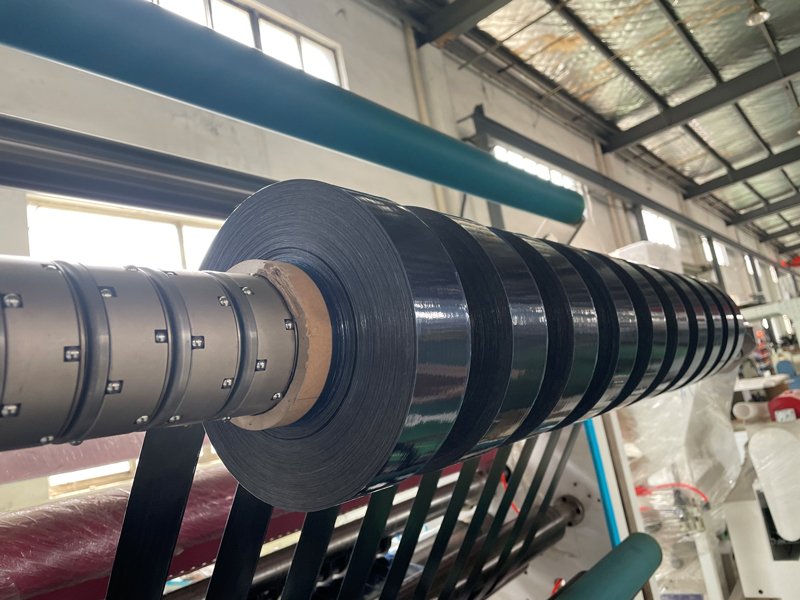
The carbon fiber prepreg can be stored at room temperature. The time is called the storage period.
If there is no low-temperature storage condition, the production volume of the prepreg must be based on the principle that it can be used up within the storage period.
The common components of prepreg are: the bottom is a layer of release paper (white), the middle is the finished prepreg (black), and the surface is covered with a layer of polyethylene film (blue), the middle of which is the finished prepreg.
It is composed of resin and fiber, as shown in the figure below.
What about carbon fiber prepreg?
In fact, it is not difficult to explain that the surface of the carbon fiber cloth is impregnated with a layer of resin, but it is not cured by heating.
Its existence is reserved for later molding and curing. It is a spare material. The industry calls it carbon fiber prepreg. What is the connection between it and carbon fiber cloth?
Carbon fiber prepreg is actually a pre-treatment product of carbon fiber cloth.
Mainly used in the industrial field, it has high requirements for transportation and storage, requiring refrigeration.
The most famous carbon fiber prepreg companies in the world are Toray, Hexcel, Cytec, Gurit and TenCate. Occupies most of the prepreg market.
The market of carbon fiber prepreg
Carbon fiber prepreg has a wide range of applications and high material properties.
It meets the modern development needs of the military, agriculture, industry, and other fields in modern countries.
Therefore, the global carbon fiber prepreg market continues to rise.
In 2019, the global carbon fiber prepreg market scale reaches 4.5 billion US dollars.
Driven by the growth of production costs and market demand, the carbon fiber prepreg market will continue to expand in the future, and the industry has great potential for future development.
Roughly the same as the global market development trend, the scale of my country’s carbon fiber prepreg market is also expanding. It will be about 1.8 billion yuan in 2019 and grow to 2.2 billion yuan by 2020.
Carbon fiber prepreg has superior performance and meets the development needs of my country’s industrial and military fields. Therefore, the current demand for applications in military and civilian equipment is high, and the industry is developing rapidly.
In terms of production, American and Japanese companies occupy a relatively high market share in the global market.
Although my country has realized the localization of carbon fiber prepregs, there is still a certain gap between the performance of local products and imports, and there is still a lot of room for development in the domestic market in the future.
At present, the more advanced foreign fighters such as F22 and F35, whose composite materials account for 26% of the overall weight of the aircraft structure, are mainly used for F22 fuselage, wings, flaps, vertical tails, ailerons, flaps, and landing gear bays.
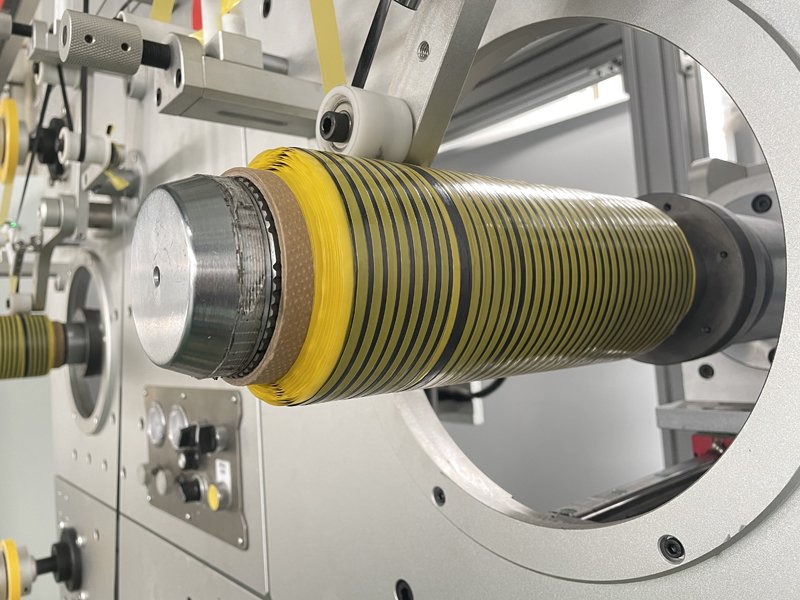
For doors, F35 is mainly used in fuselage, wings, air intakes, control surfaces, ailerons, vertical tails, etc.
The European EF-2000 prepreg material has reached 35%-40%, and a new type of large passenger aircraft for civil aviation has reached 50%-52%.
Except for some special main load-bearing structures of the fuselage, all-composite materials have been basically realized.
What is the difference between carbon fiber cloth and prepreg?
Carbon fiber cloth is a high-strength reinforcement made from carbon fiber threads. It’s light and strong. It’s anti-acid and alkali, anti-aging, anti-fatigue, and anti-corrosion.
Carbon fiber prepreg is a pre-combined resin and fiber that can be stored. It can be designed and formed during storage. It’s a composite intermediate.
Carbon fiber prepreg is made by spreading carbon fiber tow (or woven cloth) and pre-coated resin on release paper, combining, cooling, coating, winding, etc.
Carbon fiber prepreg is the intermediate composite material.
Jota Machineries offers a wide range of paper slitter rewinder machines to meet each specific requirement. Our high-speed gummed paper slitting machine can slit a rewound automatically any material that is flexible.
In order to let you know more about we Jota company, please watch the following video for reference.
We Jota could also supply the following related machines, if you are also interested in any type, please feel free to send us an inquiry:
- Hot Melt Thermoplastic CFRP CFRTP Prepreg Manufacturing Machine
- Fully Automatic Thermal Paper Roll Slitting Packing Machine
- Fully Automatic Toilet Paper Maker
- Automatic Facial Tissue Making Machine
- Plastic Film, Fabric, Aluminum Foil Slitting Rewinding Machine
- Paper Sheeter
- Paper Tube Making Machine
- CFRP CFRTP FRP Prepreg Slitter
- Paper Drinking Straws Machine
- Label Die Cutting Machine
- Flexo Printing Machine
- Cardboard Tube Cutting Machine

